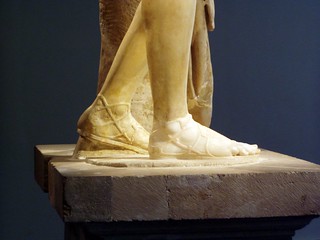The Statue of Hermes and the infant Dionysus
- Argo Crew
- Mar 15, 2022
- 2 min read
Updated: Apr 20, 2022
Hermes and the Infant Dionysus statue, believed to be made by Praxiteles, 4th century BCE
This famous statue depicts the Greek god Hermes (god of messages, thieves and merchants) holding the baby god Dionysus (the god of wine and fertility).
STATUE LOCATION:

In Melbourne, you can see this statue at the Hellenic Museum. The museum statue is a copy of the original made by the sculptor Praxiteles in the 4th century BCE.
The original statue of Hermes and baby Dionysus was placed in the ancient temple of Hera at Olympia – the original home of the Olympic Games. Even today the flame that lights the Olympic torch is lit at the temple ruins.
STATUE FEATURES:

You might be wondering why Hermes is shown holding the baby Dionysus in this statue.
According to the Greek myth, Dionysus’ father Zeus handed Dionysus over to Hermes, after the baby’s mother Semele was killed by Zeus’s jealous wife Hera (queen of gods). In turn, Hermes took the baby to the mountain nymphs so that they could raise him.
Archaeologists who found the original statue of Hermes and Dionysus at Olympia in 1877 noticed that the statue had traces of red pigment (paint) on Hermes’ sandal straps.
This pigment would have been made from a mineral called cinnabar. In ancient times, statues like this were painted with bright colours. Over the centuries the colours have faded.
PRAXITELES: THE MASTER SCULPTOR

Archaeologists believe that Praxiteles created the statue of Hermes and the infant Dionysus. Praxiteles was one of the most skilled ancient Greek sculptors from Attica (an area near Athens).
Praxiteles’ sculptures were very life-like and depicted the perfect human body in a natural way. He used Parian marble (the finest in Greece), to make the Hermes statue. The statue is very smooth and shiny – in real life, the statue looks like it is glowing!
You can see that the body of the Hermes statue has an S shape. This is called the S-curve of Praxiteles. Praxiteles shaped his statues’ bodies to rest on their right legs, with their right hip curved out. This stance actually looks like a relaxing way that any of us might stand in real life!
Compare Praxiteles’ style in the image on the left with earlier Archaic Greek statue style (on the right). The Archaic style copied the stiff look of Egyptian statues.
Which statue looks more life-like to you?
CURIOUS? LEARN MORE ABOUT HERMES THE MESSENGER AND TRICKSTER GOD
Check out this fun video to learn more about Hermes!













Comments